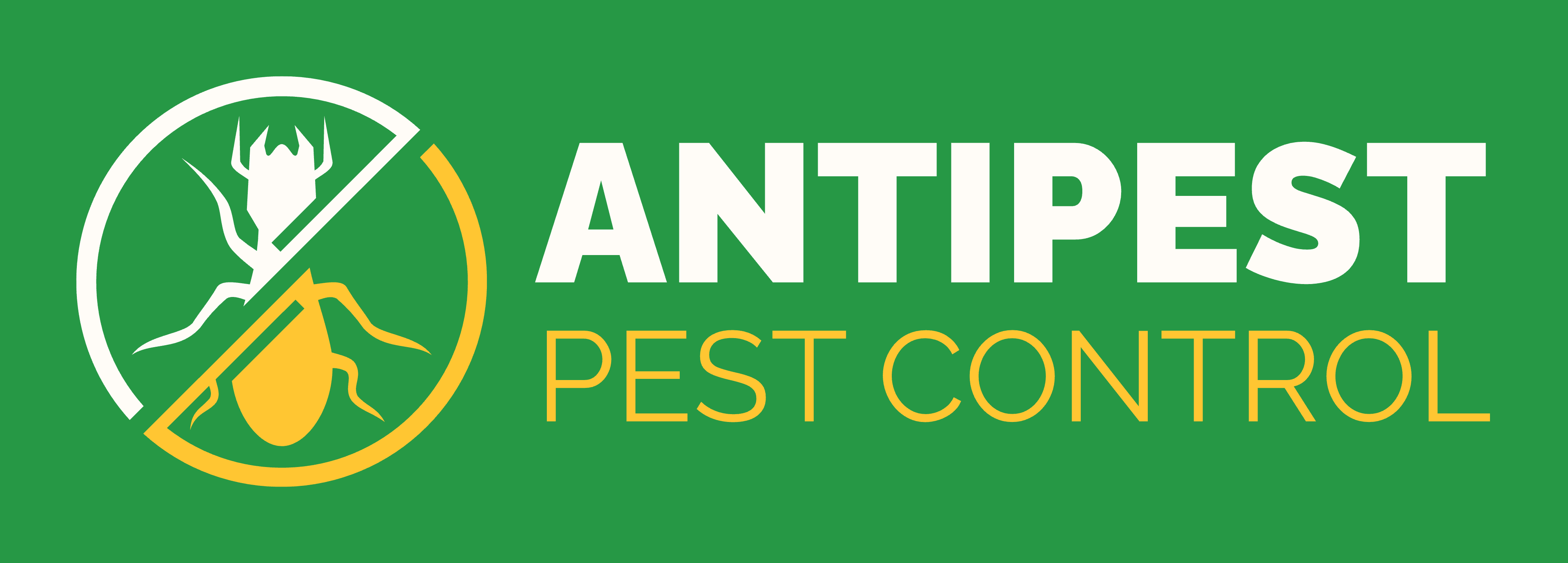When warm summer evenings arrive, homeowners often notice swarms of small winged insects buzzing around lights or crawling indoors. Understanding the difference between flying ants vs termites is crucial, as both sprout wings during mating season but have vastly different impacts on your property. While flying ants are mostly temporary nuisances, termites can silently compromise your home’s structural integrity.
This guide explores flying ants vs termites in depth, showing you how to identify, prevent, and handle infestations effectively. Whether you’re facing swarms around your porch light or suspect wood damage indoors, you’ll learn exactly how to distinguish between these insects and protect your home. By mastering flying ants vs termites identification, you’ll know when to take simple preventive steps versus calling for emergency pest control.
Table of Contents
What Do Termites Look Like?
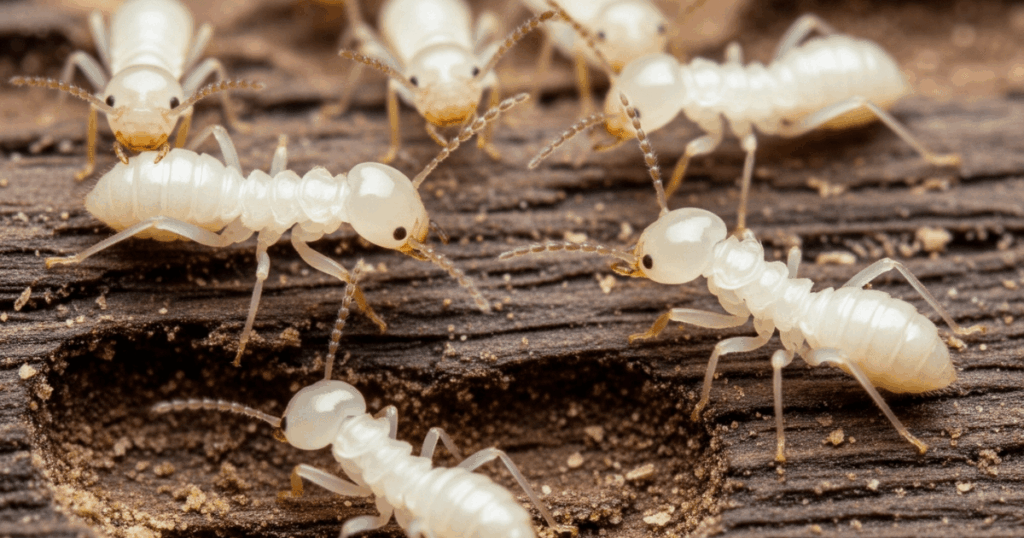
Homeowners frequently misjudge Flying Ants vs Termites because termites don’t always appear with wings. Termite workers are pale and wingless, while swarmers have long equal wings.
Termite characteristics:
- Uniform, soft body with no waist narrowing.
- Straight, beaded antennae.
- Cream to pale-brown coloration.
- Equal-sized wings among reproductives.
Understanding these distinctions keeps you from mixing up termites with ants.
What Do Flying Ants Look Like?
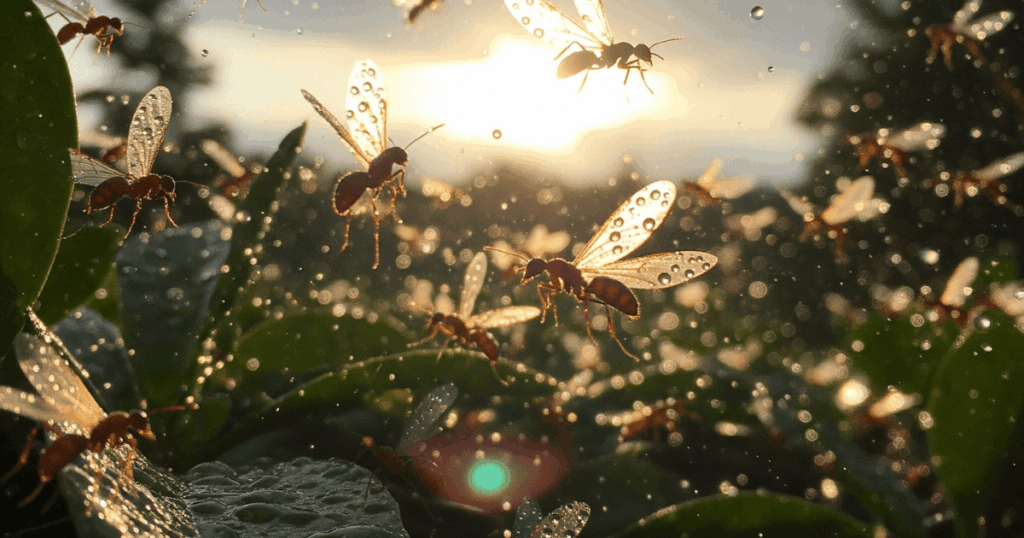
Spotting Flying Ants vs Termites involves knowing how winged ants differ. Flying ants strongly resemble regular ants, but their temporary wings set them apart during swarms.
Features of flying ants:
- Dark glossy exoskeleton, typically brown/black.
- Pinched waist, slim profile.
- Front wings are longer than back wings.
- Bent antennae that are easy to identify.
Their harmless appearance often misleads homeowners into assuming they are termites.
Commonly Mistaken for Flying Ants vs Termites
Several insects are often confused with Flying Ants vs Termites, especially during warm evenings when swarms appear. The sudden presence of buzzing insects near lights or windows leaves many homeowners struggling with identification.
Common mistaken insects include:
- Carpenter bees – Larger, heavy-bodied insects drilling into wood.
- Mayflies – Harmless insects found around lakes or ponds in swarms.
- Winged beetles – Look similar in shape to termites but have hard wing covers.
- Gnats and swarm flies – Very small and harmless, but appear in huge numbers.
Insects Mistaken for Flying Ants vs Termites
| Insect Type | Resembles More | Key Difference | Risk Level |
| Carpenter Bees | Flying Ants | Larger, noisy hovering | Wood drilling outside only |
| Mayflies | Termites | Swarm near water, short-lived | No threat |
| Winged Beetles | Termites | Hard body with visible wings | Minimal nuisance |
| Gnats/Swarm Flies | Flying Ants | Tiny, weak fliers | Harmless annoyance |
How to Distinguish Between Flying Ants vs Termites?
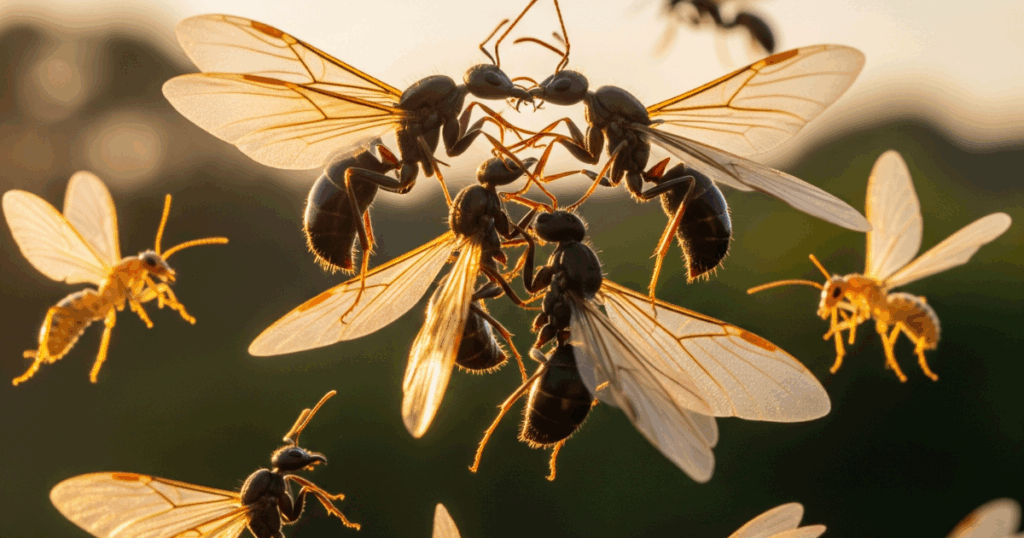
One of the most important questions for homeowners is how to clearly distinguish Flying Ants vs Termites. They both appear in swarms and look deceptively similar.
Distinct features to note:
- Antennae: Bent (ants) vs straight (termites).
- Waist: Narrow/pinched (ants) vs broad (termites).
- Wings: Unequal length (ants) vs equal size (termites).
By learning these unique differences, you can immediately tell Flying Ants vs Termites apart and take appropriate actions.
Distinguishing Factors
| Feature | Flying Ants | Termites |
| Antennae | Elbowed | Straight |
| Waist | Pinched | Broad |
| Wings | Uneven | Equal |
Spot the Difference: Flying Termite vs. Flying Ant
A Flying Termite vs Flying Ant comparison is essential because both emerge in massive swarms during mating seasons. Experts stress that knowing how to separate these helps avoid misdiagnosis of a dangerous infestation.
Key identifiers:
- Flying termites = pale soft body, equal wings, broad waist, straight antennae.
- Flying ants = darker body, pinched waist, unequal wings, elbowed antennae.
This direct observation ensures homeowners never confuse Flying Ants vs Termites during inspection.
Flying Ants vs Termites Difference
When comparing Flying Ants vs Termites, the biological and behavioral differences are clear. While ants are often just nuisances, termites can silently devour a home.
Differences include:
- Diet: Ants eat proteins and sugars; termites consume cellulose.
- Body shape: Ants have three noticeable sections; termites look tube-like.
- Risk: Flying ants are short-lived; termites remain destructive all year.
Flying Ants vs Termites: Quick Identification Table
| Feature | Flying Ants | Termites |
| Antennae | Elbowed | Straight |
| Waist | Narrow, pinched | Broad, uniform |
| Wings | Unequal pairs | Equal pairs |
| Activity Period | Summer, early fall | Spring, post-rain |
| Damage Potential | Minimal nuisance | High structural threat |
| Treatment | Baits, barriers, prevention | Baits, fumigation, soil barriers |
“Discover the surprising differences between red ants vs black ants – and learn which one you should really watch out for!”
How to Tell the Difference Between Flying Ants vs Termites?
A clear procedure guarantees correct identification of Flying Ants vs Termites.
Checklist for homeowners:
- Observe antennae (bent or straight).
- Look at waist shape (narrow or broad).
- Compare wings (unequal or equal size).
- Note habitat (sugar trails = ants, wood tunnels = termites).
This practical approach reduces confusion and speeds up treatment.
How to Get Rid of Flying Ants vs Termites?
Getting rid of Flying Ants vs Termites involves entirely different methods. Ants may be controlled by cleaning and baiting, while termites demand robust extermination plans.
Flying ant control:
- Clean food sources.
- Use sprays and bait traps.
- Seal entry points.
Termite control:
- Apply termiticide barriers.
- Install bait stations.
- Seek professional extermination services.
Physical Differences Between Flying Ants vs Termites
The most reliable way to tell flying ants vs termites apart is by closely observing their physical traits. Each insect has signature markers that can be spotted with the naked eye.
Antennae Shape
Flying ants have elbowed antennae that bend sharply in the middle, while termites have straight, beaded antennae. This detail alone can immediately separate the two when inspected closely.
Waist Shape
Another standout feature is the waist. Flying ants have a pinched or narrow waist, much like regular ants. Termites, however, have a broad waist, giving their bodies a straighter cylindrical appearance.
Wing Size and Shape
Both insects have two pairs of wings, but their proportions differ noticeably:
- Flying ants: Front wings are longer than the back wings, and their wings are uneven in length.
- Termites: Both pairs of wings are the same size and shape, extending much longer than the abdomen.
Table: Physical Differences Between Flying Ants vs Termites
| Feature | Flying Ants | Termites |
| Antennae | Bent (“elbowed”) | Straight, beaded |
| Waist | Pinched/narrow | Broad, straight |
| Wings | Unequal pairs (front longer than hind wings) | Equal-sized, long wings |
| Body Color | Reddish-brown or black | Pale white/cream to light brown |
| Texture | Hard exoskeleton, glossy | Softer body, less shiny |
Life Cycle of Flying Ants vs Termites
Understanding their development clarifies how infestations grow.
- Flying Ants Life Cycle: Egg → Larvae → Pupae → Adult. Alates emerge seasonally for mating flights. Male ants often die soon after, while queens establish new nests.
- Termite Life Cycle: Egg → Nymph → Worker/Soldier/Reproductive. Winged reproductives leave to start new colonies. Termites stay active year-round, continuously feeding on wood.
The critical difference? Termites feed on cellulose their entire lives, directly targeting structural components of homes. Flying ants, in contrast, seek out sugars, proteins, or crumbs, not your walls.
Behavior and Habitat Preferences : Flying Ants vs Termites
Identifying physical features is helpful, but knowing the behavioral differences between flying ants vs termites provides deeper context. These insects thrive in distinct environments and leave behind specific signs of their presence.
Flying Ant Behavior
- Swarm during warmer months, often after rain.
- Typically nest in soil, under woodpiles, or inside wall voids.
- Feed on sweets, proteins, and organic debris.
- Known for being temporary nuisances rather than destructive pests.
Termite Behavior
- Swarm in spring or early summer (depending on species).
- Build colonies underground, inside wood, or in damp soil layers.
- Feed primarily on cellulose, the main component in wood and paper.
- Known for causing billions of dollars worth of damage annually worldwide.
Habitat Preferences
| Aspect | Flying Ants | Termites |
| Nest location | Soil, walls, decayed wood | Soil, wooden structures |
| Food sources | Sugars, organic debris | Cellulose-rich materials |
| Typical lifespan | Several weeks to months | Years (in colonies) |
| Threat level to humans | Minor nuisance | Severe structural damage |
Learn how to get rid of wood eating insects and keep your furniture safe for years.
Signs of Infestation Between Flying Ants vs Termites
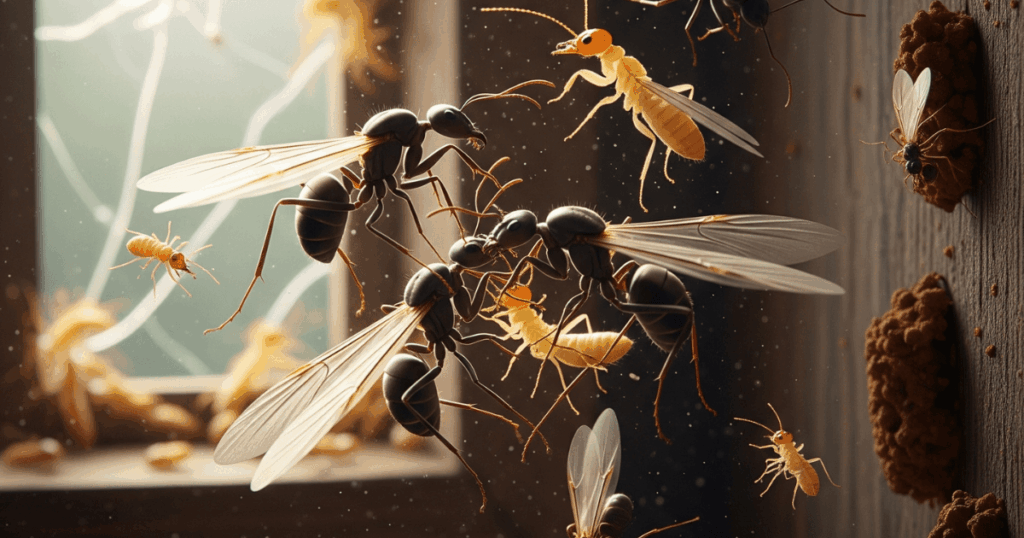
Recognizing signs can help you determine whether you’re dealing with flying ants vs termites. Since termite damage can quietly accumulate, quick detection is especially important.
Signs of Flying Ants
- Winged ants swarming around windows or lights.
- Small piles of discarded wings near window sills.
- Trails of ants seeking sugary foods indoors.
- Minor damage if nesting within walls but not structural collapse.
Signs of Termites
- Hollow-sounding wood that easily breaks.
- Mud tubes crawling up foundation walls.
- Buckling floors or sagging window frames.
- Accumulation of frass (termite droppings) resembling tiny pellets.
Flying Ants vs Termites Damage
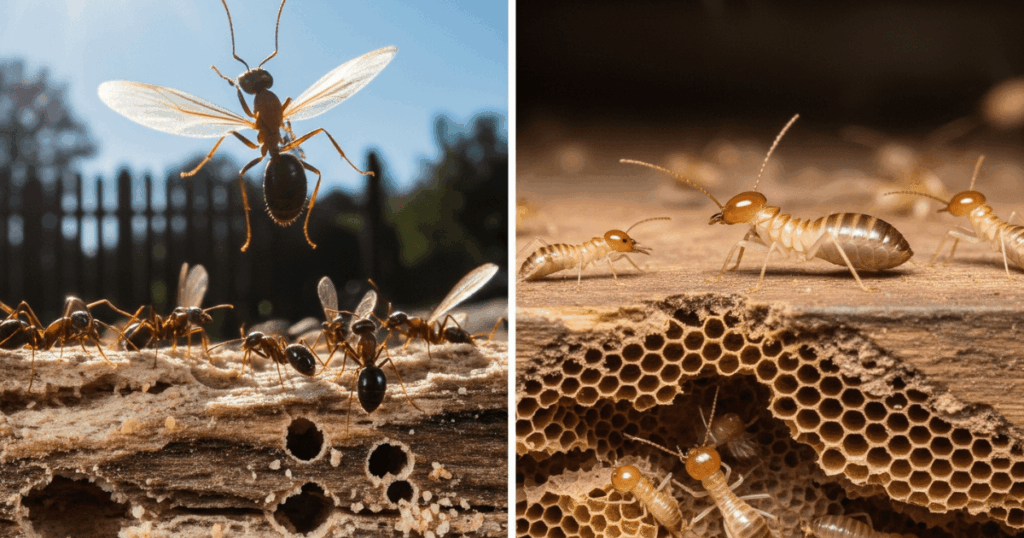
The Flying Ants vs Termites debate escalates when homeowners wonder about damage. Ants seldom cause costly repairs unless carpenter ants burrow wood. Termites, on the other hand, can destroy foundational structures.
Termite damage:
- Hollow beams and crumbling floors.
- Mud tunnels along foundations.
- Expensive structural repairs.
Ant damage:
- Pantry infestations.
- Surface-level wood nesting from carpenter ants.
- Minor household inconvenience compared to termites.
Flying Ants vs Termites: Damage Comparison
To highlight just how different these two insects are in terms of risk, let’s compare their destructive potential.
| Aspect | Flying Ants | Termites |
| Structural Damage | Minimal | Severe wood destruction |
| Feeding Habits | Sugars, crumbs, seeds | Cellulose (wood, paper, drywall) |
| Cost of Damage | Low | Billions annually across the U.S. |
| Response Needed | Preventive measures | Immediate professional treatment |
Despite looking similar while swarming, the damage caused by termites is on another level altogether.
Causes of Flying Ant vs Termite Swarms
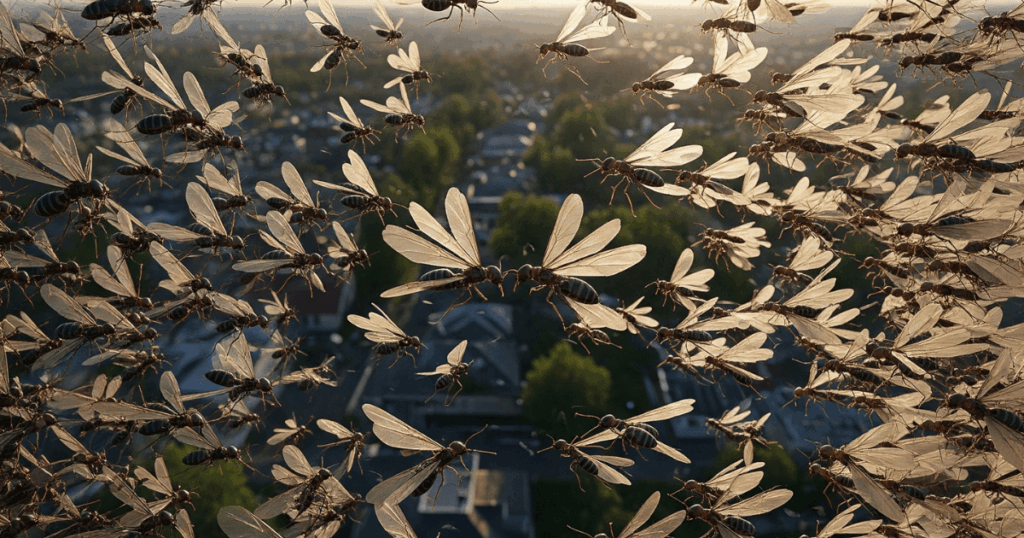
Why do these insects suddenly appear in your home or yard?
- Warm, humid weather after rain triggers mating flights.
- Mature colonies release reproductive alates.
- Indoor appearance often means a nearby colony in the soil, wood, or structure.
Both species are stimulated by weather patterns, though their nesting sites differ, ants in soil or cracks, termites inside wood and moist foundations.
How to Prevent Infestations of Flying Ants vs Termite
Identifying flying ants vs termites early is important, but prevention matters even more.
Preventing Flying Ants
- Seal food and clean spills quickly.
- Seal gaps and cracks in walls/doors.
- Reduce moisture by fixing leaks.
Preventing Termites
- Keep soil away from wooden foundations.
- Repair leaky pipes to eliminate dampness.
- Store firewood away from the home’s foundation.
- Regular professional inspections.
A homeowner who maintains both sanitation and proper building care rarely has to deal with large infestations.
Treatment Solutions
If prevention fails, knowing how to treat flying ants vs termites is vital. Treatments should focus on eliminating existing colonies while preventing future outbreaks.
Treating Flying Ant Infestations
- Use bait traps to reduce colonies.
- Spray insecticidal dust into cracks and crevices.
- Apply boric acid in problem areas.
- If nests are inside walls, professional treatment may be needed.
Treating Termite Infestations
- Apply termiticides in soil around the home.
- Install baiting systems that eliminate entire colonies.
- Use physical barriers during construction like steel mesh.
- Professional technicians are essential since DIY termite control is rarely effective long-term.
Professional Pest Control for Flying Ants vs Termites
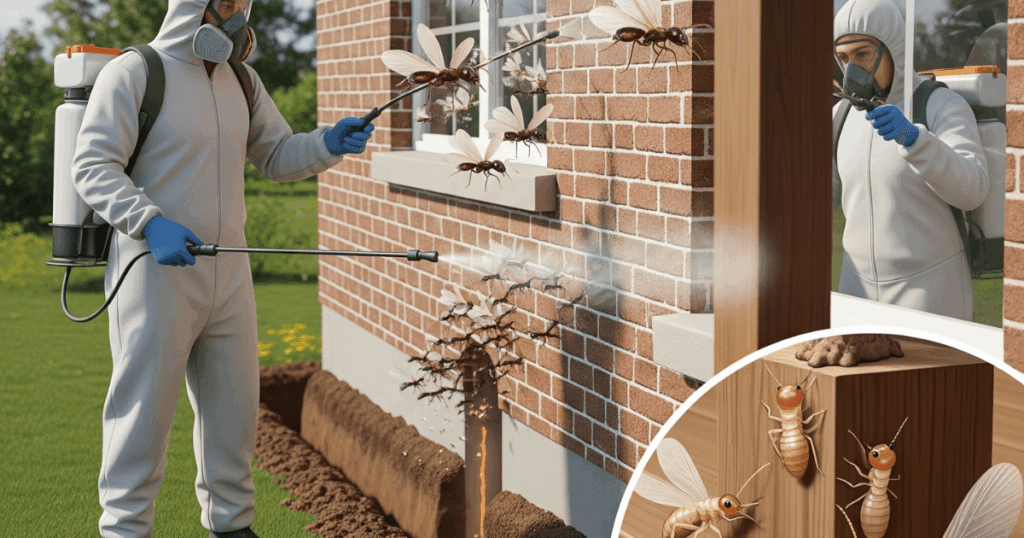
Calling a licensed exterminator ensures safe, effective control. Professionals use monitoring systems to distinguish between ant and termite colonies. Termites are particularly challenging due to hidden colonies inside walls or under flooring. Pest control teams may suggest:
- Termite trench-and-treat systems
- Soil termiticide barriers
- Ant bait and residual surface sprays
For comprehensive and hassle-free Flying Ants vs Termites removal and long-term pest prevention, trust the professionals at Antipest Office. Visit us at the Antipest Office, Our trained technicians use safe and effective methods to protect your home and business. For service bookings and consultations, call us at +91 9819018398 .
Professional expertise guarantees the correct identification of flying ants vs termites, reducing risks of structural damage from misdiagnosis.
Conclusion
While they may look similar when swarming, the critical distinction between flying ants vs termites lies in the damage they cause. Flying ants are mostly harmless seasonal nuisances, while termites silently and continuously destroy wooden structures, causing billions in property damage annually.
Knowing the difference between flying ants vs termites helps homeowners take the right step, simple preventive measures for ants and immediate professional action for termites. Ultimately, the choice is clear: understanding flying ants vs termites could mean the difference between brushing off a minor annoyance and saving your house from thousands in repairs.
Flying Ants vs Termites? – FAQs
What are the main differences between Flying Ants vs Termites?
Flying ants have bent antennae, narrow waists, and uneven wings, while termites have straight antennae, broad waists, and equal-sized wings.
How can I identify Flying Ants vs Termites in my home?
Check wings, antennae, and waist shape. Ants have pinched waists and unequal wings, while termites have broad waists and equal-sized wings.
Why are Flying Ants vs Termites often confused by homeowners?
Both swarm during warm, humid weather and look alike with wings, but ants are seasonal nuisances, while termites cause destructive structural damage.
Do Flying Ants vs Termites cause the same kind of damage?
No. Flying ants usually cause little to no structural damage, while termites feed on wood and can weaken foundations silently over time.
When do Flying Ant vs Termite most commonly swarm?
Flying ants typically swarm in late summer after rainfall, while termites usually swarm in spring or early summer depending on species.
What should I do if I see Flying Ants vs Termites indoors?
If you spot flying ants, clean and seal food sources. For termites, schedule a professional inspection immediately to prevent severe wood damage.
Are there behavioral differences between Flying Ants vs Termites?
Yes. Flying ants forage for sugars and proteins, while termites continuously eat cellulose, thriving in damp wood and hidden underground colonies.
How do pest control experts treat Flying Ants vs Termites differently?
Professionals use sprays and baits for ants, while termites require soil termiticides, colony bait systems, and year-round monitoring.
Why is it important to know the difference between Flying Ants vs Termites?
Because ants are temporary nuisances, but termites cause costly, long-term structural damage. Early identification ensures proper prevention and treatment.
Can moisture problems attract Flying Ant vs Termites to a home?
Yes. Moist environments draw both pests. Flying ants seek damp nesting spots, while termites thrive in wet wood and soil, increasing infestation risks.

